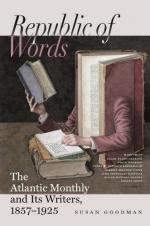But neither Shakspeare’s satire nor Florio’s absurdities are comprehended within this single character. Subsequent examination of the text of “Love’s Labor’s Lost” has enabled the critics to satisfy themselves that the part of Don Adnano de Armado, the “phantastical courtier,” was devised to exhibit another phase in the character of the Resolute Italian. In Holofernes we have the pedantic tutor; in Don Adriano a lively picture of a ridiculous lover and pompous retainer of the court.
By a fine dramatic touch, Shakspeare has made each describe the other, in such a way that the portrait might stand for the speaker himself, and thus establishes a dual-identity. Thus, Armado, describing Holofernes, says, “That’s all one, my fair, sweet, honey monarch; for I protest the schoolmaster is exceeding fantastical,—too, too vain,—too, too vain; but we will put it, as they say, to fortuna della guerra";—whilst Holofernes, not behind his counterpart in self-esteem, sees in the other the defects which he cannot detect in himself. “Novi hominem tanquam te” quoth he;—“his humor is lofty; his discourse peremptory; his tongue filed; his eye ambitious; his gait majestical; and his general behavior vain, ridiculous, and thrasonical. He is too picked, too spruce, too affected, too odd, as it were; too peregrinate, as I may call it; he draweth out the thread of his verbosity finer than the staple of his argument. I abhor such fanatical phantasms,” etc.
Should further proof be needed that Florio, Holofernes, and Armado form a dramatic trinity in unity, we can find it in the personal appearance of the Italian. There was something amiss with the face of the Resolute, which could not escape the observation of his friends, much less his enemies. A friend and former pupil of his own,—Sir Wm. Cornwallis, speaking in high praise of Florio’s translation of Montaigne, observes,—“It is done by a fellow less beholding to Nature for his fortune than to wit; yet lesser for his face than his fortune. The truth is, he looks more like a good fellow than a wise man; and yet he is wise beyond either his fortune or education.” [9] It is certain, then, that, behaving like a fool in some things, he looked very like a fool in others.
Is it not a remarkable coincidence, that both his supposed dramatic counterparts have the same peculiarity? When Armado tells the ‘country lass’ he is wooing, that he will ‘tell her wonders,’ she exclaims,—’skittish female’ that she is,—’What, with that face?’ And when Holofernes, nettled with the ridicule showered on his abortive impersonation of Judas Maccabaeus, says, ’I will not be put out of countenance,’—Byron replies, ‘Because thou hast no face.’ The indignant pedant justifies, and, pointing to his physiognomy, inquires, ‘What is this?’ Whereupon the waggish courtiers proceed to define it: it is ‘a cittern-head,’ ‘the head of a bodkin,’ ’a death’s-face in a ring,’ ‘the face of an old Roman coin, scarce seen,’ and so forth.




